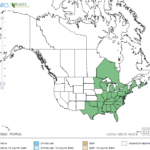Potamogeton pulcher
USDA, NRCS. 2018. The PLANTS Database (http://plants.usda.gov, 28 March 2018). National Plant Data Team, Greensboro, NC 27401-4901 USA.
Illustration: USDA-NRCS PLANTS Database / Britton, N.L., and A. Brown. 1913. An illustrated flora of the northern United States, Canada and the British Possessions. 3 vols. Charles Scribner’s Sons, New York. Vol. 1: 76.
What is Spotted Pondweed?
Physical Characteristics
Leaves:
- Partially covered in spots
Submersed Leaves:
- Alternate
- Thin
- Sword shaped
- Wavy edges
- Dark green in color
Floating Leaves:
- Light to dark green
- Oval-shaped
- Leaf stalks black or purple
Flowers:
- Above water
- Densely clustered spikes
- Many small flowers
- 4 small petals
- Green in color
Fruit:
- Olive, dark green or brown in color
- Round or oval-shaped
- 3 ridges on surface
Stem:
- Covered in spots
Where Does it Grow?
Spotted pondweed can be found in shady, muddy areas around ponds, lakes and marshes.
Pros and Cons of Spotted Pondweed
Submerged portions of all aquatic plants provide habitats for many micro and macro invertebrates. These invertebrates in turn are used as food by fish and other wildlife species (e.g. amphibians, reptiles, ducks, etc.). After aquatic plants die, their decomposition by bacteria and fungi provides food (called “detritus”) for many aquatic invertebrates.


